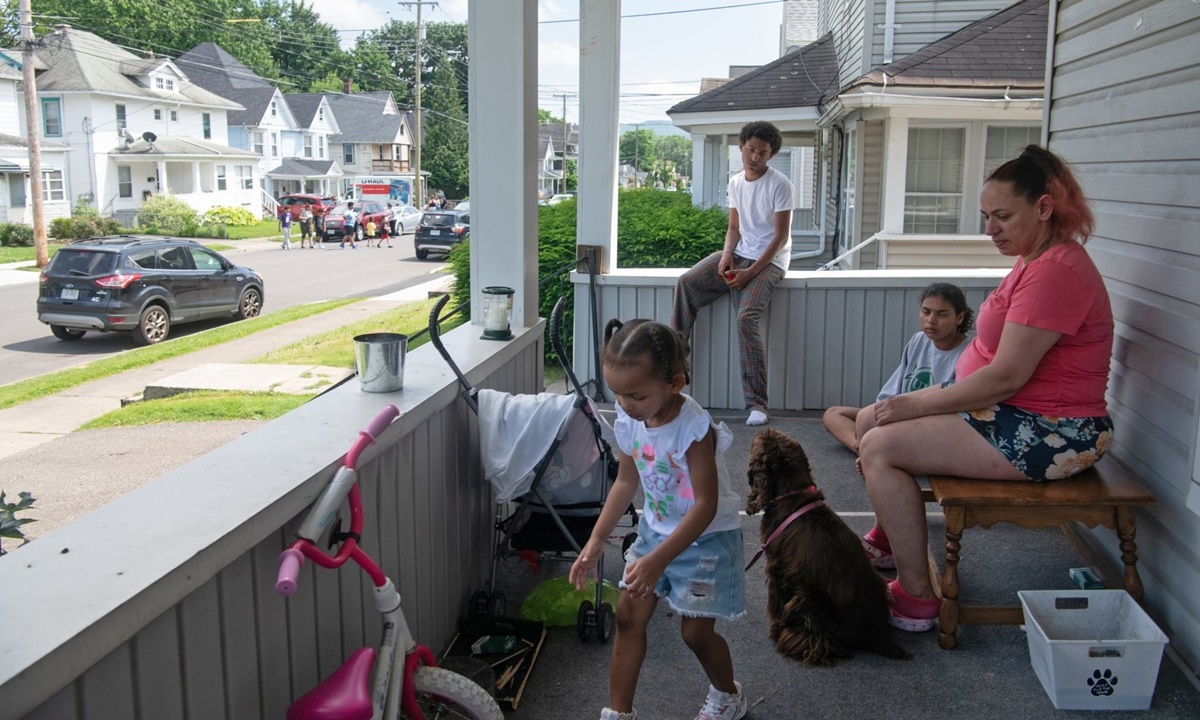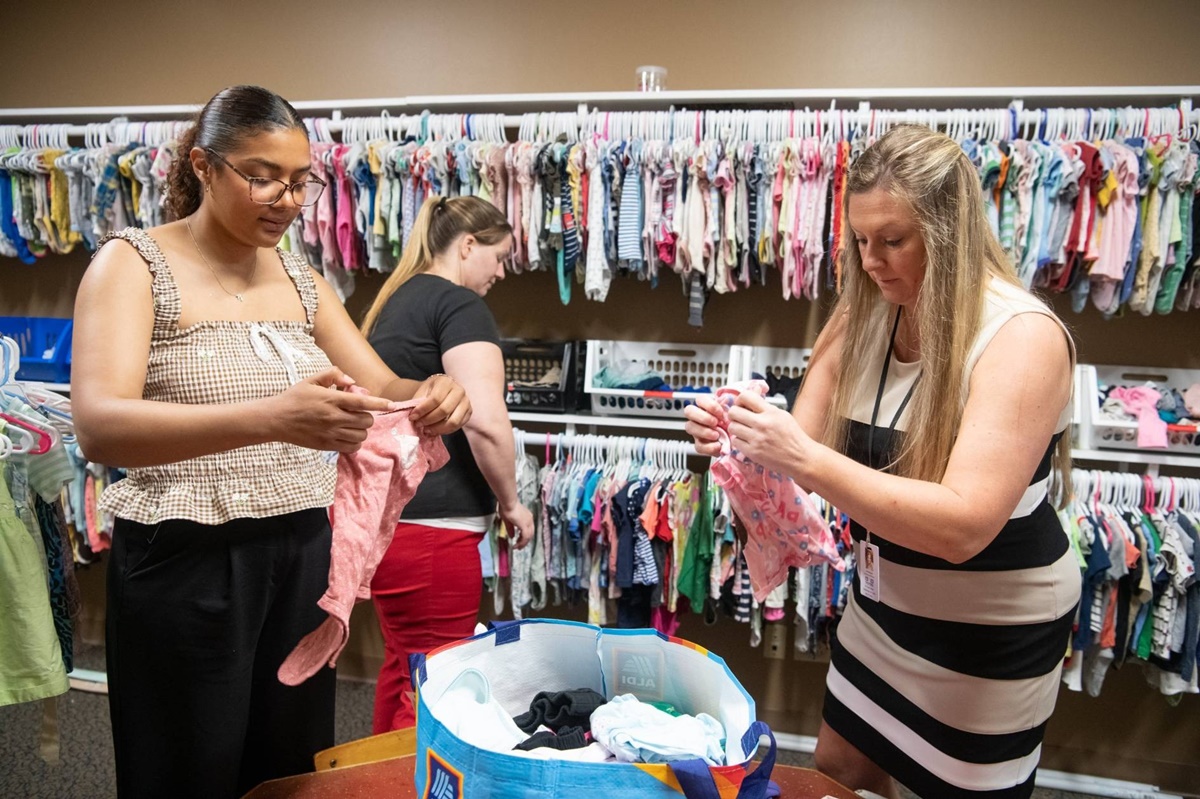By government standards, Lisa Meazler’s family isn't considered poor.
Meazler works for a non-profit organization, earning 37,500 USD per year. She owns a small house with a yard in the suburbs of Binghamton, Broome County, New York.
Many nights, 43-year-old Meazler wonders where her life is headed. She hasn't been able to take her three daughters, ages 7, 13, and 22, on vacation for years. Her heart aches when Emmi, her middle child, asks why they can't have "normal dinners" like other families.
 |
Felica Allen spends time with her children on the porch of their home near Binghamton, New York. Photo: WSJ |
Felica Allen spends time with her children on the porch of their home near Binghamton, New York. Photo: WSJ
Emmi wants home-cooked meals, not cheap frozen dinners. Meazler explains that they don't have much money to spare.
"Mom, we're fine," Emmi says, plopping down on the living room sofa after basketball practice. "Yes, we're fine," Meazler replies with a smile.
When her children aren't around, she sometimes cries.
Meazler has maxed out her credit cards. She's constantly behind on her cell phone bill. She regularly makes late payments on her 865 USD monthly mortgage. Last December, Meazler received a letter from social services approving her for 253 USD in monthly food assistance.
"Sometimes I ask myself, 'What did I do wrong?'", she says.
According to the latest 2023 data from the U.S. Census Bureau, nearly 10 million American children live in poverty, the highest number since 2018. The bureau uses the Official Poverty Measure (OPM) as the government's official poverty measure. Under this standard, a family of four with an income below 32,150 USD is considered poor.
Tens of millions of other children are near the poverty line, like Meazler’s family. They are being pushed to the brink by a range of economic factors, including the expiration of Covid-19 relief programs and inflation driving up food and housing costs.
The pressure is expected to worsen due to federal spending cuts to support programs, such as food stamps and Medicaid. On 4/7, President Donald Trump signed a law that reduces funding and tightens work requirements for those seeking government assistance.
Even before these cuts, several indicators showed American families with young children struggling.
According to census data compiled by the Center on Poverty & Social Policy at Columbia University, the percentage of families with young children living in poverty jumped to 12.9% in 2023. This rate had fallen to a record low of 5.6% in 2021, thanks to pandemic-era programs like the expanded Child Tax Credit and supplemental unemployment benefits.
Poverty rates for all ages increased slightly, but no age group saw as dramatic a jump from 2021 to 2023 as children.
According to 2023 census data from Luke Shaefer, an economist at the University of Michigan, approximately 35 million children, nearly half of all children in the U.S., live in households below what experts consider the lowest rung of the middle class. Shaefer said this number is at its highest in five years.
"For every child in poverty, there are two to three more above the poverty line but still struggling," Shaefer said. They are in "families that work incredibly hard but never get ahead."
This reality is evident in Broome County, New York. According to estimates from census models, more than one-fourth of the county's 36,100 children lived in poverty in 2022, a nearly 50% increase from 2021. While the rate declined in 2023, nonprofits that help financially strapped families have seen a surge in demand over the past year.
In 2024, the Food Bank of the Southern Tier received over 92,000 requests for food assistance for children in the county through three main local programs. This figure is approximately 9,000 more than in 2023 and nearly double the 2019 figure.
In 11/2024, the United Way of Broome County announced it had exhausted its rental assistance funds for families. This occurred several weeks earlier than in previous years, indicating the fund couldn't keep up with the growing housing needs.
At Mothers & Babies, the nonprofit where Meazler works, the number of new mothers referred for items ranging from cribs to baby clothes has doubled in the past year.
Meazler sees herself in many of the mothers she meets, those working jobs that barely cover basic needs. They stay up late researching government assistance programs and which bills they can delay. They can't save a penny.
With a population of about 196,000, Broome County has consistently had a high child poverty rate for a decade. It wasn't always this way.
IBM was born here when three of America's first information-processing companies merged in 1911 and established headquarters in the village of Endicott.
IBM brought jobs and financial stability to generations of residents. The company’s presence in Broome County began to dwindle in the 1990s as IBM moved manufacturing elsewhere and laid off workers. The company sold its headquarters in 2002, though it continued to lease some buildings. It all ended in 2023.
 |
Demolition of the former IBM headquarters in Endicott in June. Photo: WSJ |
Demolition of the former IBM headquarters in Endicott in June. Photo: WSJ
"The closure of IBM sent the local economy into a tailspin," said Komla Dzigbede, chair of the Public Administration and Policy department at Binghamton University in Broome County. "In many ways, it never fully recovered."
However, Dzigbede said there are signs of economic recovery. For example, in 2023 USD, the median household income in Broome increased from 59,044 USD in 2013 to 63,590 USD in 2023.
But according to Zillow, a popular online real estate marketplace in the U.S., rental costs in Broome County have nearly doubled in recent years, putting pressure on residents. The average rent for an apartment increased from 694 USD in 5/2018 to 1,292 USD in 5/2025.
"We’re dealing with a broken system where minimum wage does not support a family’s cost of living," said Christie Finch, associate director of Mothers & Babies. "Families are having to choose between paying rent, buying food or paying for heat."
Last year, her group distributed clothing and baby supplies to 174 families, up from 86 families in 2023. In the first six months of this year, they have provided food assistance to 151 families, compared with 90 families during the same period in 2024.
Last year, Broome County had an average unemployment rate of just 4%. Longtime social service workers say they’re surprised to see families with rising incomes struggling more than ever.
According to Abigail Wozniak, a labor market economist at the Federal Reserve Bank of Minneapolis, wages for low-income earners have also increased, similar to other groups. However, according to analysis from Jeff Horwich, a senior specialist at the bank, federal data shows that poorer households have been hit harder by inflation over the past four years.
A recent report by the Federal Reserve Bank of New York indicates that low-income earners spend a large portion of their income on housing and food, two areas that have seen significant price increases.
Some working families in Broome now rely more on public assistance programs. However, if their wages increase, even slightly, they may no longer qualify for state and federal aid.
Jennifer Lesko, executive director of the United Way of Broome County, said her caseworkers have seen numerous clients have their food or housing assistance partially cut after receiving raises or working extra hours.
"It’s really unbelievable that someone can earn a few extra dollars in a pay period and immediately lose benefits," she said. "But it happens quite frequently."
Felica Allen, a 39-year-old single mother and certified nursing assistant, works the night shift in the emergency room at UHS Wilson Medical Center near Binghamton. Each morning, she returns home to care for her four children, ages 3 to 17. Her fifth child, 22, moved out in 9/2024.
Her 20 USD hourly wage increased to 22.9 USD last year. Allen's total income in 2024 reached approximately 39,000 USD. This is the most she has ever earned, but it's not far above the poverty line.
Allen says it isn't enough to cover her living expenses. Her financial situation has worsened even as she earns more.
Before Christmas last year, she received a letter from social services informing her that her monthly Supplemental Nutrition Assistance Program benefits, federally funded, had been cut from nearly 1,000 USD to 564 USD because of her higher earned income.
"I went to work that night in tears," Allen said. "I’m like, how am I going to feed my family now when I was barely making it before?"
Last summer, she moved from a two-bedroom house to a five-bedroom house renting for 1,950 USD a month through Section 8, a federal housing program that assists low-income earners. The program pays 750 USD towards her rent, leaving Allen to cover the remaining 1,200 USD.
After taxes, her monthly income ranges from 2,400 to 2,600 USD. Allen has fixed expenses including a 162 USD car payment, 287 USD for car insurance, 400 USD for phone and internet service each month, and an electric bill that can exceed 500 USD due to past-due payments.
What remains covers toilet paper, toothpaste, gas and other necessities.
In March, she decided to reduce her weekly work hours from 32 to 26 to regain 220 USD in food assistance.
Despite the raise, Allen frequently pays her rent late. She has to borrow from her sister, aunt and friends to make ends meet.
Allen said she feels stuck in an endless cycle, constantly calculating which bills to pay immediately and which ones can be delayed. Her power has been threatened to be shut off in recent months because of overdue bills.
"I never want to be in debt. I don’t want to owe anybody anything," she said.
Meazler had detailed plans for her tax refund this year. After paying for house repairs, car repairs and other expenses, she used some of it to take her three daughters to visit her ailing mother in Georgia. Meazler still couldn't afford to buy Emmi the bigger bed she’s been wanting, or a scooter like her friends have.
 |
Meazler (right) and a colleague sort through donated clothes at Mothers & Babies, the non-profit where she works. Photo: WSJ |
Meazler (right) and a colleague sort through donated clothes at Mothers & Babies, the non-profit where she works. Photo: WSJ
She said she maintains a casual relationship with the father of her two youngest daughters. He occasionally takes them for outings, but Meazler only asks for financial help in emergencies. Recently, Meazler’s 22-year-old daughter found a part-time job paying 15.5 USD an hour, minimum wage in many parts of New York.
The Georgia trip was something the whole family looked forward to. Meazler set aside 800 USD from her tax refund for a rental car and gas for the more than 2,000-mile round trip.
One morning during their week at her mother’s house, Meazler took her daughters to Panama City Beach, a few hours’ drive away. They bought 5 USD boogie boards and ate pizza. Meazler remembers smiling as she watched her girls play on the beach. For the first time in a long time, her worries seemed to melt away.
A few days after Meazler returned home to Endicott, her mother was hospitalized with kidney failure. Meazler had to take time off work and use the rest of her tax refund to buy a plane ticket back to Georgia. She then fell behind on her April and May house payments.
"I feel like I’ve been in survival mode my whole life. Just working, working, working," she said. "Working for nothing."
Vu Hoang (According to WSJ, AFP, AP)












